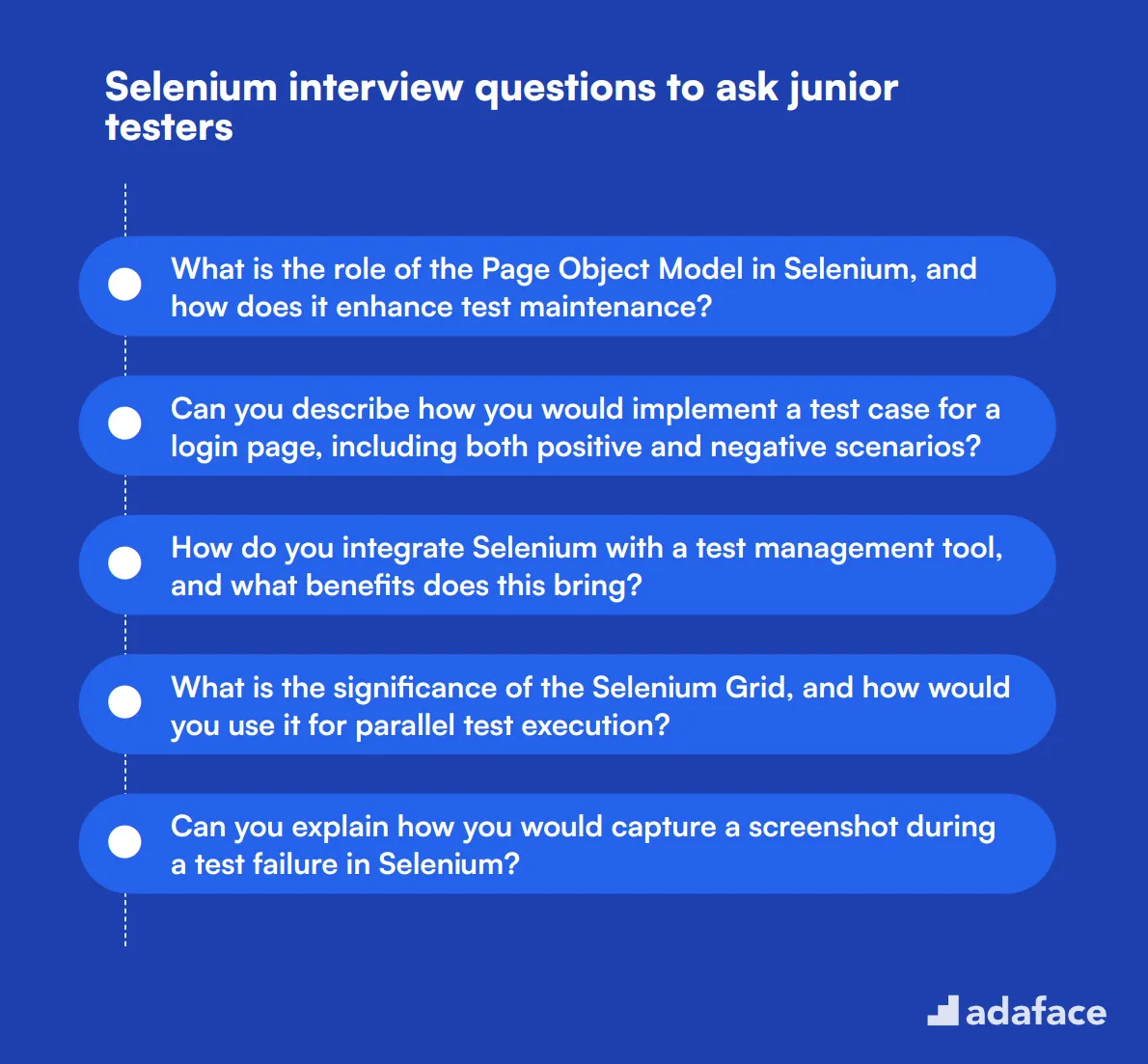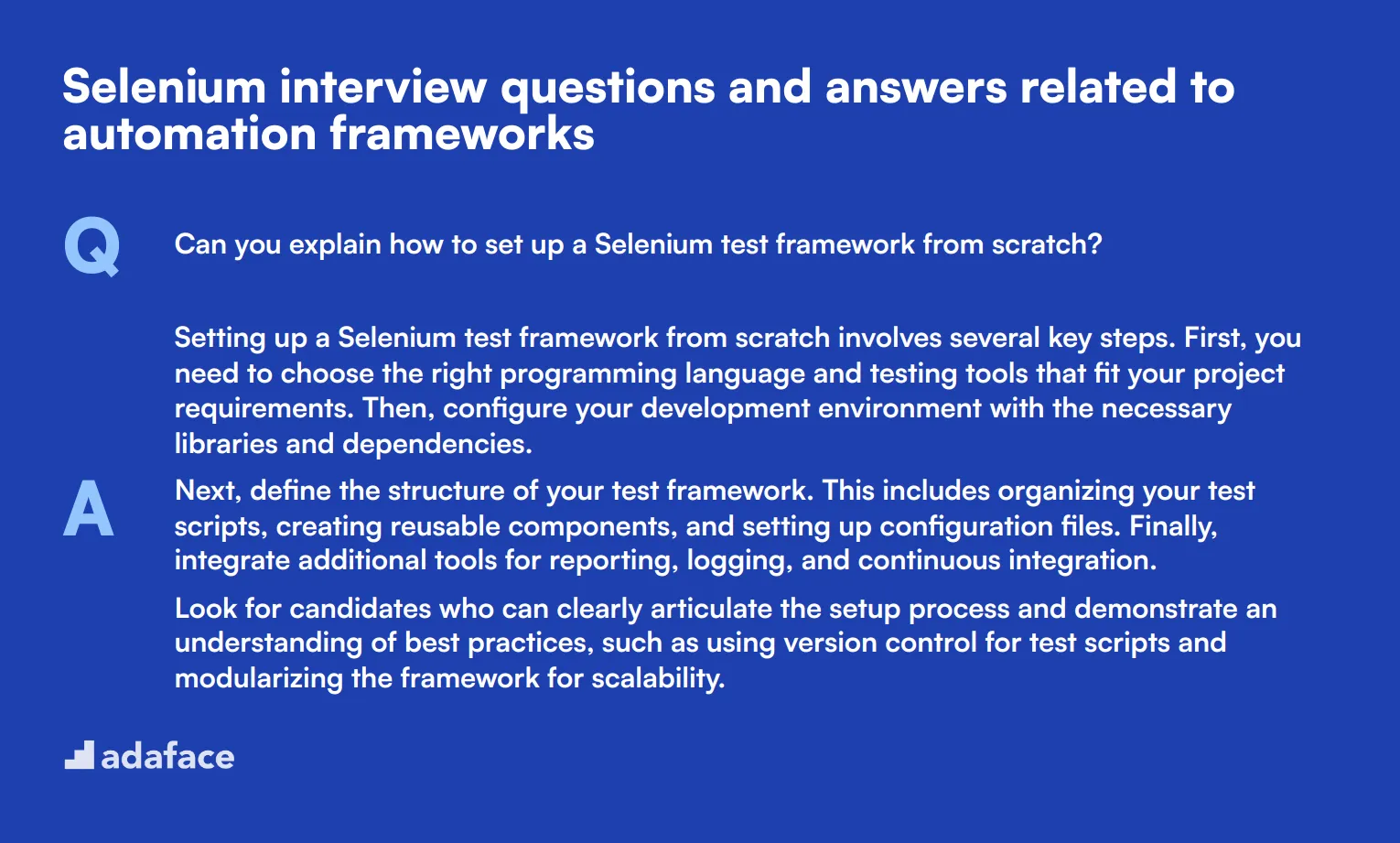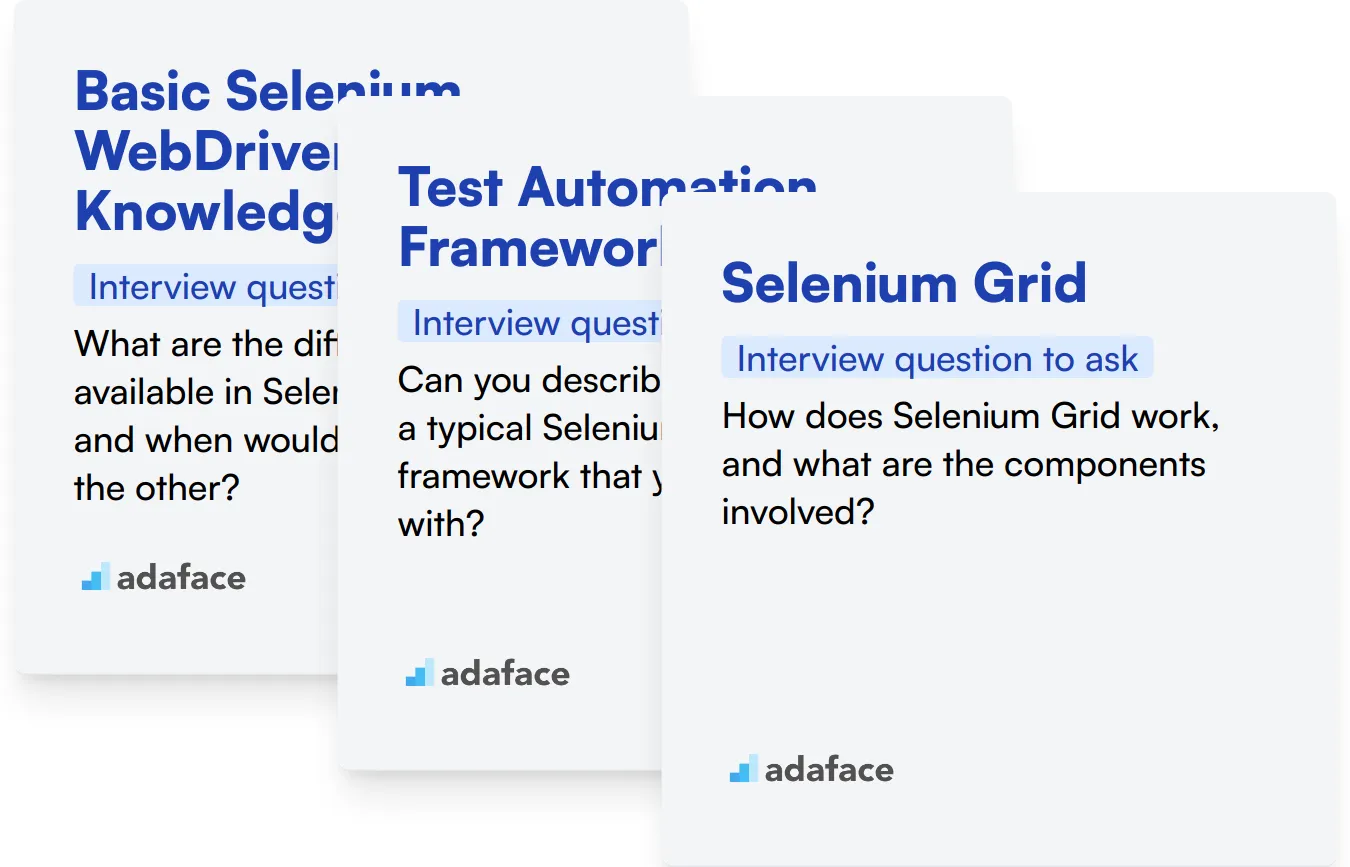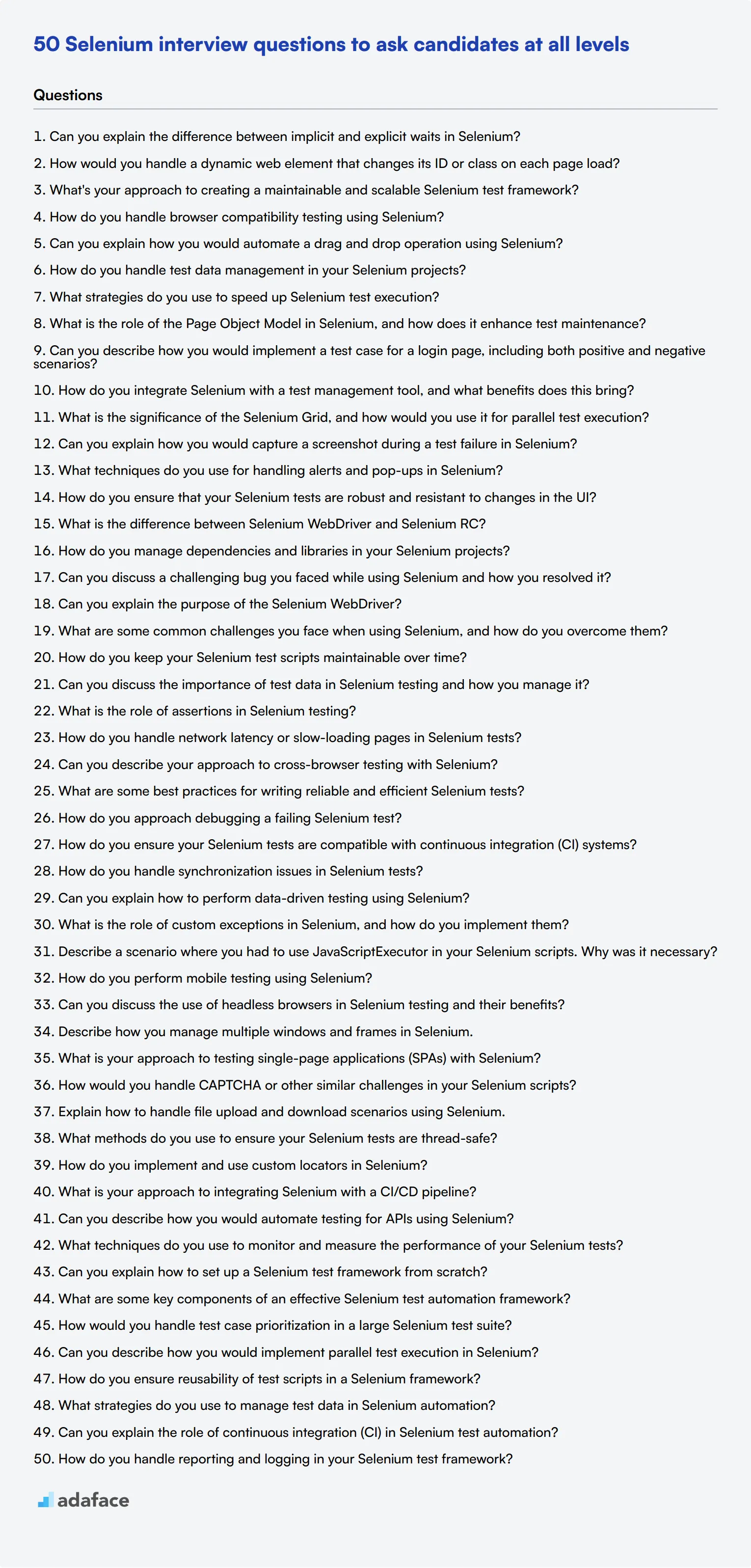Hiring the right Selenium automation tester is crucial for maintaining quality in software development. Knowing which questions to ask during interviews helps recruiters and hiring managers identify candidates with the necessary skills and expertise for the role.
This blog post provides a comprehensive list of Selenium interview questions tailored for different experience levels. We cover top questions for general interviews, as well as specific sets for junior, mid-tier, and senior testers, along with questions related to automation frameworks.
By using these questions, you can effectively evaluate candidates' Selenium knowledge and problem-solving abilities. Consider combining these interview questions with a pre-employment Selenium assessment for a more thorough evaluation process.
Table of contents
Top 7 Selenium questions to ask in interviews

Ready to dive into the world of Selenium interviews? These top 7 questions are your secret weapon for uncovering a candidate's true automation testing prowess. Use them to spark insightful discussions and gauge both technical know-how and problem-solving skills. Remember, the best interviews feel more like a friendly chat than an interrogation!
1. Can you explain the difference between implicit and explicit waits in Selenium?
Implicit waits tell WebDriver to wait for a certain amount of time before throwing a 'No Such Element Exception'. Once set, the implicit wait is applied to all elements during the lifetime of the WebDriver object. It's like telling Selenium, 'Hey, give the page a chance to load before you panic!'
Explicit waits, on the other hand, allow you to wait for specific conditions to occur before proceeding with execution. You can set it to wait for elements to be clickable, visible, or present. It's more precise and usually preferred for reliable testing.
Look for candidates who can clearly articulate the differences and explain scenarios where each type of wait is more appropriate. A strong answer will also touch on the potential pitfalls of relying too heavily on implicit waits.
2. How would you handle a dynamic web element that changes its ID or class on each page load?
A skilled Selenium tester should mention several strategies for dealing with dynamic elements:
- Using partial matches with contains(), starts-with(), or ends-with() in XPath
- Leveraging stable attributes or parent-child relationships
- Creating custom dynamic locators
- Implementing wait strategies to allow the element to load
An ideal response would include a real-world example of how they've tackled this issue in the past. Listen for candidates who emphasize the importance of robust, maintainable locators in their test scripts.
3. What's your approach to creating a maintainable and scalable Selenium test framework?
A strong answer should touch on several key points:
- Implementing the Page Object Model for better organization and reusability
- Using a configuration file for environment-specific data
- Creating utility classes for common functions
- Implementing proper logging and reporting mechanisms
- Using version control and following coding best practices
Look for candidates who emphasize the importance of code readability, modularity, and ease of maintenance. They should also mention strategies for handling test data and managing different test environments.
4. How do you handle browser compatibility testing using Selenium?
A comprehensive answer should include:
- Using WebDriver for different browsers (ChromeDriver, GeckoDriver, etc.)
- Implementing a factory design pattern for easy browser switching
- Utilizing cloud-based solutions like Sauce Labs or BrowserStack for a wider range of browsers and versions
- Discussing strategies for parallel test execution across multiple browsers
Pay attention to candidates who mention the importance of prioritizing browsers based on user analytics and those who discuss handling browser-specific quirks in their test scripts.
5. Can you explain how you would automate a drag and drop operation using Selenium?
A good answer should outline the following steps:
- Locate the source and target elements
- Use the Actions class to create a drag and drop action
- Perform the action using the build() and perform() methods
Candidates might also mention alternative methods like using JavaScript for more complex scenarios. Look for those who discuss potential challenges, such as handling dynamic elements or cross-browser compatibility issues in drag and drop operations.
6. How do you handle test data management in your Selenium projects?
Strong candidates should discuss multiple approaches to test data management:
- Using external files (CSV, Excel, JSON) to store test data
- Implementing a database for more complex data sets
- Utilizing data-driven testing frameworks
- Considering data generation tools for creating large volumes of test data
Look for answers that emphasize the importance of data independence from test scripts, ease of maintenance, and the ability to run tests with different data sets. Candidates who mention strategies for handling sensitive data or discuss data cleanup after test execution demonstrate a thorough understanding of test data management.
7. What strategies do you use to speed up Selenium test execution?
An experienced Selenium tester should mention several optimization techniques:
- Implementing parallel test execution
- Using headless browser testing for non-UI dependent tests
- Optimizing locator strategies (preferring ID and CSS over XPath)
- Minimizing the use of Thread.sleep() in favor of explicit waits
- Utilizing page load strategies effectively
- Implementing proper test data management to reduce setup time
Look for candidates who can explain the trade-offs between speed and reliability, and who understand the importance of maintaining test stability while improving execution time. A mention of continuous integration practices in relation to test execution speed is also a plus.
10 Selenium interview questions to ask junior testers

To evaluate whether candidates possess the foundational knowledge and skills needed for Selenium testing, utilize this list of practical questions. These inquiries can help you discern their understanding of essential concepts and their ability to apply them in real-world scenarios. For more insights on the role, check out this Selenium automation tester job description.
- What is the role of the Page Object Model in Selenium, and how does it enhance test maintenance?
- Can you describe how you would implement a test case for a login page, including both positive and negative scenarios?
- How do you integrate Selenium with a test management tool, and what benefits does this bring?
- What is the significance of the Selenium Grid, and how would you use it for parallel test execution?
- Can you explain how you would capture a screenshot during a test failure in Selenium?
- What techniques do you use for handling alerts and pop-ups in Selenium?
- How do you ensure that your Selenium tests are robust and resistant to changes in the UI?
- What is the difference between Selenium WebDriver and Selenium RC?
- How do you manage dependencies and libraries in your Selenium projects?
- Can you discuss a challenging bug you faced while using Selenium and how you resolved it?
10 intermediate Selenium interview questions and answers to ask mid-tier testers

To determine whether your applicants have the right level of expertise to handle intermediate Selenium tasks, ask them some of these carefully curated questions. They'll help you gauge their problem-solving skills, familiarity with Selenium practices, and ability to maintain test scripts.
1. Can you explain the purpose of the Selenium WebDriver?
The Selenium WebDriver is a tool for automating web application testing to verify that they work as expected. It allows you to perform tests across different browsers by simulating browser actions like clicking, typing, and navigating.
A strong answer should include how WebDriver differs from Selenium RC, emphasizing its direct communication with the browser without needing an intermediate server, leading to faster and more reliable tests.
2. What are some common challenges you face when using Selenium, and how do you overcome them?
Candidates may mention challenges like dealing with dynamic web elements, handling pop-ups and alerts, and ensuring cross-browser compatibility. They might also talk about maintaining test scripts and making them resistant to UI changes.
Look for answers that include specific strategies for overcoming these challenges, such as using explicit waits for dynamic elements, leveraging try-catch blocks for unexpected pop-ups, and designing modular and reusable test scripts.
3. How do you keep your Selenium test scripts maintainable over time?
Maintaining test scripts involves following best practices like using the Page Object Model (POM) to separate test logic from UI manipulation. Regularly updating locators and using descriptive naming conventions also help.
Ideal candidates should emphasize the importance of code reviews, regular updates, and adhering to design patterns like POM to ensure scripts remain easy to understand and modify. Mentioning the use of version control systems would be a plus.
4. Can you discuss the importance of test data in Selenium testing and how you manage it?
Test data is critical in validating that the application behaves as expected under various conditions. Managing test data involves creating, storing, and maintaining accurate and relevant datasets. This can include using test databases, data pools, or mock data.
Strong candidates should discuss techniques like data-driven testing, where tests are run with different sets of data, and the use of external data sources like CSV files or databases. They should also touch on ensuring data privacy and security.
5. What is the role of assertions in Selenium testing?
Assertions are used to verify that the application under test behaves as expected. They help confirm that the output of the application matches the expected result, thereby validating the functionality being tested.
Candidates should be able to explain different types of assertions like hard and soft assertions and when to use each. They should also discuss how assertions help in identifying failures early and improve the reliability of the tests.
6. How do you handle network latency or slow-loading pages in Selenium tests?
Handling network latency or slow-loading pages typically involves using explicit waits to pause the test execution until certain conditions are met, such as an element becoming visible or clickable.
Candidates should mention specific strategies like using WebDriverWait in combination with ExpectedConditions to manage these scenarios effectively. They should also highlight the importance of setting appropriate timeout values to balance test speed and reliability.
7. Can you describe your approach to cross-browser testing with Selenium?
Cross-browser testing ensures that the web application works correctly across different browsers and versions. Selenium supports this by providing WebDriver implementations for various browsers like Chrome, Firefox, and Safari.
An ideal answer should include the use of browser-specific drivers, setting up test environments for different browsers, and possibly using tools like Selenium Grid for parallel test execution. Mentioning the importance of testing on popular browsers and their versions would also be relevant.
8. What are some best practices for writing reliable and efficient Selenium tests?
Best practices include writing clear and concise test cases, using descriptive names for test methods, and following the DRY (Don't Repeat Yourself) principle to avoid code duplication. It's also important to handle exceptions properly and use waits to synchronize test execution with the application state.
Look for candidates who emphasize the importance of maintaining test scripts, using modular design patterns like the Page Object Model, and regularly reviewing and updating tests to keep them aligned with application changes. Mentioning the use of continuous integration tools for automated test execution is a plus.
9. How do you approach debugging a failing Selenium test?
Debugging a failing Selenium test starts with understanding the error message and identifying where the failure occurred. This might involve reviewing the test logs, taking screenshots at failure points, and stepping through the test code using a debugger.
Candidates should highlight their methodical approach to debugging, including isolating the issue, checking for common problems like stale element references, and verifying that the test environment is correctly set up. Mentioning the use of tools and techniques for efficient debugging would be beneficial.
10. How do you ensure your Selenium tests are compatible with continuous integration (CI) systems?
Ensuring compatibility with CI systems involves designing tests to be stable, reliable, and capable of running in different environments without manual intervention. This includes setting up the test environment programmatically and using environment variables for configuration.
Look for answers that discuss the integration of Selenium tests with CI tools like Jenkins, GitLab CI, or CircleCI. Candidates should mention the importance of running tests in headless mode for faster execution and ensuring that test results are reported back to the CI system for easy monitoring.
15 advanced Selenium interview questions to ask senior testers

To ensure you identify top-notch candidates for senior testing roles, use these advanced Selenium interview questions. They will help you assess the depth of a candidate's technical skills and their ability to handle complex testing scenarios.
- How do you handle synchronization issues in Selenium tests?
- Can you explain how to perform data-driven testing using Selenium?
- What is the role of custom exceptions in Selenium, and how do you implement them?
- Describe a scenario where you had to use JavaScriptExecutor in your Selenium scripts. Why was it necessary?
- How do you perform mobile testing using Selenium?
- Can you discuss the use of headless browsers in Selenium testing and their benefits?
- Describe how you manage multiple windows and frames in Selenium.
- What is your approach to testing single-page applications (SPAs) with Selenium?
- How would you handle CAPTCHA or other similar challenges in your Selenium scripts?
- Explain how to handle file upload and download scenarios using Selenium.
- What methods do you use to ensure your Selenium tests are thread-safe?
- How do you implement and use custom locators in Selenium?
- What is your approach to integrating Selenium with a CI/CD pipeline?
- Can you describe how you would automate testing for APIs using Selenium?
- What techniques do you use to monitor and measure the performance of your Selenium tests?
8 Selenium interview questions and answers related to automation frameworks

Hiring the right automation tester can be a game-changer for your team. Use these Selenium interview questions and answers to delve into candidates' understanding of automation frameworks, ensuring they can build robust, maintainable, and scalable testing solutions.
1. Can you explain how to set up a Selenium test framework from scratch?
Setting up a Selenium test framework from scratch involves several key steps. First, you need to choose the right programming language and testing tools that fit your project requirements. Then, configure your development environment with the necessary libraries and dependencies.
Next, define the structure of your test framework. This includes organizing your test scripts, creating reusable components, and setting up configuration files. Finally, integrate additional tools for reporting, logging, and continuous integration.
Look for candidates who can clearly articulate the setup process and demonstrate an understanding of best practices, such as using version control for test scripts and modularizing the framework for scalability.
2. What are some key components of an effective Selenium test automation framework?
An effective Selenium test automation framework typically includes several key components: a structured test script organization, reusable functions and libraries, a robust reporting mechanism, and tools for logging and debugging.
Additionally, the framework should support data-driven testing and integration with continuous integration/continuous deployment (CI/CD) pipelines. Using a modular approach allows for easier maintenance and scalability.
Ideal candidates should mention specific components and explain their importance. They should highlight their experience with integrating these components and their approach to maintaining the framework over time.
3. How would you handle test case prioritization in a large Selenium test suite?
In a large Selenium test suite, test case prioritization is essential to ensure efficient test execution. One approach is to categorize tests based on their importance and impact on the application. Critical path tests and high-risk areas should be prioritized for execution.
Additionally, using techniques like risk-based testing and code coverage analysis can help in determining which tests to run first. It's also useful to regularly review and update the prioritization criteria based on changes in the application or requirements.
Look for candidates who can explain their prioritization strategy and provide examples from their past experience. They should be able to discuss how they balance thoroughness with efficiency in their testing approach.
4. Can you describe how you would implement parallel test execution in Selenium?
Parallel test execution in Selenium can significantly reduce the overall test execution time. This is typically achieved using tools like Selenium Grid, which allows you to run tests concurrently on multiple machines or browsers.
To implement parallel execution, you need to configure the Grid with a hub and multiple nodes. Then, modify your test scripts to specify the desired capabilities and run them in parallel. It's also important to ensure that your tests are independent and thread-safe.
Candidates should be able to explain the configuration process and discuss the benefits and challenges of parallel execution. They should also mention any specific tools or frameworks they have used to achieve this.
5. How do you ensure reusability of test scripts in a Selenium framework?
Ensuring reusability of test scripts in a Selenium framework involves writing modular and maintainable code. One common approach is to use the Page Object Model (POM), which separates the test scripts from the page-specific details.
Additionally, creating reusable functions and libraries for common actions and validations can help reduce code duplication. It's also important to use proper naming conventions and maintain a clear structure for your test scripts and supporting files.
Look for candidates who can discuss their experience with creating reusable components and their approach to maintaining them. They should be able to provide examples of how they have implemented POM or other design patterns in their projects.
6. What strategies do you use to manage test data in Selenium automation?
Managing test data in Selenium automation involves several strategies. One common approach is to use external data sources like CSV files, Excel sheets, or databases to store test data. This allows for easy updates and maintenance of the test data.
Another strategy is to use data-driven testing, where the test scripts are parameterized to run with different sets of data. This helps in covering various test scenarios and improving test coverage.
Candidates should mention their experience with different data management techniques and tools. They should also explain how they ensure the integrity and consistency of test data across different test environments.
7. Can you explain the role of continuous integration (CI) in Selenium test automation?
Continuous integration (CI) plays a crucial role in Selenium test automation by ensuring that code changes are automatically tested and integrated into the main codebase. This helps in catching issues early and maintaining the quality of the application.
Implementing CI involves setting up a CI server (e.g., Jenkins, TeamCity) to trigger automated tests whenever there is a code change. The CI server runs the Selenium test suite and generates reports, which can be reviewed by the development and QA teams.
Candidates should discuss their experience with CI tools and their approach to integrating Selenium tests into the CI pipeline. They should also highlight the benefits of CI, such as faster feedback and improved collaboration between teams.
8. How do you handle reporting and logging in your Selenium test framework?
Reporting and logging are essential components of a Selenium test framework. For reporting, tools like TestNG, JUnit, or ExtentReports are commonly used to generate detailed test reports with information on test execution, pass/fail status, and error messages.
Logging can be implemented using libraries like Log4j or SLF4J to capture detailed logs of the test execution process. These logs help in debugging and identifying issues in the test scripts or the application under test.
Look for candidates who can explain their approach to setting up reporting and logging in their test framework. They should also discuss how they use these tools to monitor test execution and troubleshoot issues.
Which Selenium skills should you evaluate during the interview phase?
Conducting a Selenium interview is challenging because a single session cannot capture the full breadth of a candidate’s skills and experience. However, there are core competencies that every interviewer should focus on to gauge the candidate’s proficiency in Selenium effectively.

Basic Selenium WebDriver Knowledge
A strong understanding of Selenium WebDriver is fundamental for any Selenium tester. This includes familiarity with its API, ability to write and execute scripts, and knowledge of how to interact with different types of web elements.
To assess this, you can use our Selenium online test that includes relevant multiple-choice questions (MCQs). This will help you filter candidates who possess the essential WebDriver skills.
During the interview, you can also ask targeted questions to evaluate their understanding of WebDriver. Here’s a question you might consider:
What are the different locators available in Selenium WebDriver, and when would you use one over the other?
Look for candidates who can list various locators such as ID, name, XPath, CSS selector, and explain their use cases effectively. Their ability to choose the right locator depending on the scenario will indicate their proficiency.
Test Automation Frameworks
Understanding different test automation frameworks like TestNG, JUnit, or Cucumber is crucial because they help in structuring test cases, generating reports, and running tests efficiently.
Our Selenium online test includes questions on test automation frameworks to ensure the candidate has hands-on experience with these essential tools.
To dive deeper, you might ask the following question:
Can you describe the structure of a typical Selenium test automation framework that you have worked with?
Look for detailed answers that cover aspects like the folder structure, build management tools (e.g., Maven, Gradle), test runner configurations, and reporting mechanisms. The candidate’s familiarity with these components shows their practical experience.
Selenium Grid
Knowledge of Selenium Grid is important for executing tests on multiple machines and browsers. It helps in parallel testing and aids in reducing execution time.
You can further evaluate this skill by asking:
How does Selenium Grid work, and what are the components involved?
Expect the candidate to explain the roles of the Hub and Nodes, how they communicate, and scenarios where using Selenium Grid is beneficial. This will show their understanding of distributed testing setups.
Tips for Effective Selenium Interview Questioning
Before putting your newfound knowledge to use, consider these tips to make your Selenium interviews more effective and insightful.
1. Start with a Skills Assessment
Begin your evaluation process with a Selenium skills assessment. This approach helps you filter candidates objectively before investing time in interviews.
Use a Selenium online test to gauge candidates' practical knowledge. This test can evaluate their understanding of Selenium WebDriver, test automation frameworks, and scripting abilities.
Implementing a skills assessment allows you to focus your interviews on candidates who have demonstrated a baseline of Selenium proficiency. This streamlines your hiring process and ensures you're interviewing the most promising candidates.
2. Prepare a Balanced Set of Interview Questions
When compiling your interview questions, aim for a mix that covers various aspects of Selenium and related skills. You have limited time, so choose questions that target key areas relevant to your specific project needs.
Consider including questions about test automation frameworks, CI/CD integration, and cross-browser testing. You might also want to explore their knowledge of related tools like Cucumber for behavior-driven development.
Don't forget to assess soft skills such as problem-solving and communication. These are equally important for a tester who will need to collaborate with developers and stakeholders.
3. Use Follow-up Questions to Probe Deeper
Prepare follow-up questions to dig deeper into candidates' responses. This technique helps you distinguish between memorized answers and genuine understanding.
For example, if a candidate mentions using wait commands in Selenium, ask them to explain different types of waits and when they'd use each. This follow-up can reveal their practical experience and problem-solving approach in real-world scenarios.
Use Selenium interview questions and skills tests to hire talented testers
If you are looking to hire someone with Selenium skills, you need to ensure they have those skills accurately. The best way to do this is by using skill tests like our Selenium Online Test or QA Engineer Test.
Once you use this test, you can shortlist the best applicants and call them for interviews. To get started, you can sign up here or check out our pricing page for more details.
Selenium Online Test
Download Selenium interview questions template in multiple formats
Selenium Interview Questions FAQs
Look for proficiency in programming languages like Java or Python, understanding of web technologies, knowledge of testing methodologies, and experience with Selenium WebDriver and automation frameworks.
Ask them to explain their approach to automating a specific test scenario, discuss challenges they've faced in real projects, or even consider a short coding exercise if time permits.
Be cautious of candidates who can't explain basic Selenium concepts, lack knowledge of testing principles, or have no experience with version control systems or continuous integration.
For juniors, focus on basic concepts and tools. For mid-tier, include questions about best practices and common challenges. For seniors, delve into advanced topics like framework design and performance optimization.
Yes, it's beneficial to ask about complementary tools like TestNG, JUnit, or Jenkins to gauge the candidate's overall understanding of the testing ecosystem.

40 min skill tests.
No trick questions.
Accurate shortlisting.
We make it easy for you to find the best candidates in your pipeline with a 40 min skills test.
Try for freeRelated posts
Free resources




